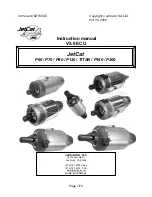
Not for
Reproduction
D.
Air Cleaner, Low Profile
E.
Dipstick
F.
Oil Fill
G.
Oil Filter
H.
Oil Drain Plug
I.
Oil Pressure Sensor
J.
Finger Guard
K.
Electric Starter
L.
Starter Solenoid
M.
Regulator/Rectifier
N.
Carburetor - Carburetor Models
O.
Oil Cooler (if equipped)
P.
Muffler (if equipped)
Q.
Fuel Pump
R.
Starter Switch
1
S.
Throttle Control
1
T.
Choke Control - Carburetor Models
1
U.
Fuel Filter (if equipped)
1
Some engines and equipment have remote controls. See the equipment manual
for location and operation of remote controls.
Engine Control Symbols and Meanings
Meaning
Symbol
Meaning
Symbol
Engine speed - SLOW
Engine speed - FAST
ON - OFF
Engine speed - STOP
Engine start - Choke OPEN
Engine start - Choke
CLOSED
Fuel Shut-off - CLOSED
Fuel Cap
Fuel Shut-off - OPEN
Fuel level - Do not overfill
Operation
Oil Recommendations
Oil Capacity: See the
Specifications section.
We recommend the use of Briggs & Stratton Warranty Certified oils for best performance.
Other high-quality detergent oils are acceptable if classified for service SF, SG, SH, SJ or
higher. Do not use special additives.
Outdoor temperatures determine the proper oil viscosity for the engine. Use the chart to
select the best viscosity for the outdoor temperature range expected.
SAE 30 - Below 40 °F (4 °C) the use of SAE 30 will result in hard starting.
A
10W-30 - Above 80 °F (27 °C) the use of 10W-30 may cause increased oil
consumption. Check oil level more frequently.
B
Synthetic 5W-30
C
5W-30
D
Check Oil Level
See Figure: 5
Before adding or checking the oil
•
Make sure the engine is level.
•
Clean the oil fill area of any debris.
1.
Remove the dipstick (A, Figure 5) and wipe with a clean cloth.
2.
Fully install the dipstick (A, Figure 5).
3.
Remove the dipstick and check the oil level. Correct oil level is at the top of the full
indicator (B, Figure 5) on the dipstick.
4.
If oil level is low, slowly add oil into the engine oil fill (C, Figure 5). Do not overfill.
After adding oil, wait one minute and then recheck the oil level.
5.
Fully install the dipstick (A, Figure 5).
Low Oil Protection System (if equipped)
Some engines are equipped with a low oil sensor. If the oil is low, the sensor will either
activate a warning light or stop the engine. Stop the engine and follow these steps before
restarting the engine.
•
Make sure the engine is level.
•
Check the oil level. See the
Check Oil Level section.
•
If the oil level is low, add the proper amount of oil. Start the engine and make sure
the warning light (if equipped) is not activated.
•
If the oil level is not low, do not start the engine. Contact a Briggs & Stratton
Authorized Service Dealer to have the oil problem corrected.
Fuel Recommendations
Fuel must meet these requirements:
•
Clean, fresh, unleaded gasoline.
•
A minimum of 87 octane/87 AKI (91 RON). High altitude use, see below.
•
Gasoline with up to 10% ethanol (gasohol) is acceptable.
NOTICE
Do not use unapproved gasolines, such as E15 and E85. Do not mix oil in
gasoline or modify the engine to run on alternate fuels. Use of unapproved fuels will
damage the engine components, which will not be covered under warranty.
To protect the fuel system from gum formation, mix a fuel stabilizer into the fuel. See
Storage. All fuel is not the same. If starting or performance problems occur, change fuel
providers or change brands. This engine is certified to operate on gasoline. The emissions
control system for this engine is EM (Engine Modifications).
High Altitude
At altitudes over 5,000 feet (1524 meters), a minimum 85 octane/85 AKI (89 RON) gasoline
is acceptable.
For carbureted engines, high altitude adjustment is required to maintain performance.
Operation without this adjustment will cause decreased performance, increased fuel
consumption, and increased emissions. Contact a Briggs & Stratton Authorized Service
6







































